1938 – 1974
In the 1930s, the Holland-America Line was truly one of the greatest companies operating ships on the North Atlantic. The company had been founded in 1870, and many renowned vessels had been in its service through the years. The proudest of them all was probably the stately Nieuw Amsterdam, which had entered service back in 1906. The Nieuw Amsterdam was never noted for her speed, her 16-knot run certainly did not make her an Atlantic greyhound. Instead it was her interiors and the magnificent service and cuisine that made this ship what it was – the greatest in the Dutch merchant fleet.
But the ‘30s brought a whole lot of changes into the picture. The Great Crash of the stock markets in 1929 sent worldwide economics crashing down, soon hitting rock bottom. As a result of this, there was a tremendous slump in the passenger shipping trade. Like so many other companies of the time, the Holland-America Line was forced to put some of their older ships out of service, simply because no work could be found for them. One of these ships was the ageing Nieuw Amsterdam, which was laid up in 1930.
To ride out this difficult financial storm, the Holland-America Line went through an extensive administrative reorganisation. With Willem van der Vorm as chairman and Willem H. deMonchy and Franciscus J. Bouman as managing directors, the company managed to gather new capital and survive the Depression. By the middle of this dramatic decade, economics were finally starting to recuperate, and by 1936 things were indeed beginning to look bright again. Passengers were returning, and the company’s funds were now sufficient to commission a new flagship, a new ship of state.
The honour of building the new flagship was given to the Rotterdam Drydock Company. The ship’s projected gross tonnage of about 35,000 tons meant that this ship was going to be the largest so far built in Holland. On January 5th 1936, the first plates of the ship’s keel were laid down. During the 13 months that followed, the new ocean giant grew on the stocks. Unlike so many other ships being built at the time, the new vessel was not constructed with any war provisions, thus earning her the nickname ‘Ship of Peace’.
Then, on April 10th 1937, the new Holland-America flagship was ready for her launch. A large crowd had gathered in the vicinity to witness the event, and the person chosen to christen the vessel was none other than Holland’s Queen Wilhelmina. Sending the ship to the waves, she gave her the name Nieuw Amsterdam – a name that had been chosen to honour the company’s one-time pride and joy.
However, the launch of the ship did by no means mean completion. Now the work of fitting her out began. Intended to represent Holland on the high seas, the Nieuw Amsterdam’s owners wanted her to sport the very latest in shipboard design. With this in mind, the top artists and designers of Holland were brought in to do the honours. Their creation emerged in the spring of 1938, a light-coloured and very spacious ship throughout. Her interiors were completely done in the modern Art Deco-style, with very clean and bright surfaces. One of the ship’s centrepieces was the main restaurant, which was adorned by numerous Murano glass light fixtures and columns covered in gold leaf. Tinted mirrors, ivory walls and satinwood furniture all contributed to create the luxurious atmosphere. The restaurant had no portholes or windows facing the open sea, making it depend solely on artificial illumination. This might sound a bit odd, but it should be noted that it was just the same in the first class restaurant on board the fabulous Normandie of 1935. Her electrically lighted restaurant earned her the affectionate nickname ‘Ship of Light’.
On April 23rd 1938, the Nieuw Amsterdam set out on her sea trials, which were to take place on the North Sea. Testing her speed and manoeuvring capability, the new vessel turned out to be all that she was supposed to be. Upon her return from the sea trials, the Nieuw Amsterdam was transferred to Holland-America ownership and officially registered in the Dutch merchant fleet.
The following month, the Nieuw Amsterdam was ready to cross the North Atlantic for the very first time. Leaving Rotterdam on her maiden voyage on May 10th, she called at Boulogne and Southampton before she set off towards her final destination – New York. The voyage was a complete success, but as the Nieuw Amsterdam was building her reputation on the North Atlantic, the political situation in Europe grew tenser by the day.
After merely a year and a half in service, the Nieuw Amsterdam left Rotterdam on what was to be her last peacetime Atlantic crossing for another eight years on November 22nd, 1939. When Nazi Germany invaded Poland on September 1st, the Second World War was a grim reality. To keep her out of harm’s way, the Nieuw Amsterdam was now used for short cruises out of New York.
On May 14th 1940, Holland was forced to capitulate to Nazi Germany. At the same time, the Nieuw Amsterdam was on a cruise in the Caribbean. Upon her return to New York, she was ordered to remain in port until further notice. Four months later, in September 1940, she was handed over to the British Ministry of Transport. The Cunard Line was chosen to act as her manager. With her regular crew on board, and Holland-America Commodore Johannes J. Bijl commanding her, the Nieuw Amsterdam sailed from New York on September 12th with Halifax as destination. There she would go through the massive transformation from a luxury liner into a troop transport.
Soon work was underway to remove the plush fittings from the grand ship. The complete vessel was more or less gutted from her exquisite interiors to make room for as many soldiers as possible. The cinema and grand hall was turned into troop dorms, filled to the limit with tier upon tier of folding steel bunks or so-called ‘standees’. Staterooms originally intended for two were made capable of housing 18. The ship’s gleaming white superstructure, her black hull and her green, yellow and white funnels were painted in battleship grey.
At the same time, the Allies were busy shipping troops from Australia and New Zealand to the battlefields of the Middle East. All ships were needed fast, and the Nieuw Amsterdam was sent ‘down under’ before she had been fitted with armaments. Instead, 36 guns were installed while the ship was in Singapore. In January of 1941, when she was finally ready to participate in the war effort, the Nieuw Amsterdam was sent to Australia to load troops. Her first trooping voyage was in fine company, in convoy with the Queen Mary, Mauretania, Aquitania, Empress of Britain and Andes, bound for Bombay.
Soon the Nieuw Amsterdam was familiar with her wartime duties, making several voyages between Suez and Durban. On one of these voyages, she carried the Greek royal family into exile in South Africa. After the United States entered the war following the Japanese attack on Pearl Harbor on December 7th1941, the Nieuw Amsterdam was employed in the Indian Ocean and the Pacific. In these waters, there was seldom any danger for air attacks, so the Nieuw Amsterdam was rather safe in spite of the violent war raging across the globe. Of course, both German and Japanese submarines operated in these surroundings, but as with the other fast liners working as troopers, the Nieuw Amsterdam’s great speed protected her from such lurking enemies. In fact, through the entire conflict, the ship was endangered only once. On Christmas Day of 1944, just outside of Halifax, a submarine was reported by planes to be some 120 miles away. However, the Nieuw Amsterdam was escorted by destroyers, and these started dropping depth charges. A little later an underwater explosion was heard and wreckage, including German books, parts of boats and oil came to the surface, so the U-boat was presumed sunk.
When 1944 was coming to its end, it was rather evident that the Allies would be victorious. But the job of defeating Hitler was not yet finished, and more soldiers were needed on the battlefields of Europe. During the last year of WWII, the Nieuw Amsterdam was employed on the North Atlantic. She made ten trips, carrying Canadian and American troops to Gourock, Scotland.
Then, after six bloody years of war, the Germans finally surrendered in the spring of 1945. Once again, there was peace in Europe. But the global conflict had not yet seen its end, as war was still raging in the Pacific. But after another four months, the Japanese were forced to an unconditional surrender. The Second World War was finally over.
During the war, millions of people had been shipped across the globe to make their contribution to whatever side that had been on. Now it was time to take them back to their homes. The great ocean liners were called in to do the job. The Nieuw Amsterdam was indeed no exception. Among other things, she was used to transport Dutch citizens from the East Indies back to Holland. When she was finished with her repatriation tasks, the Nieuw Amsterdam was handed back to the Holland-America Line on April 8th 1946, and two days later she returned to her homeport of Rotterdam. The company now faced the challenge of returning their flagship into her pre-war self. For that purpose, the ship was sent back to her original builders on May 22nd.
The project was certainly not an easy one. After six years of war, the shortage of material was great. It took fifteen weeks to free the Nieuw Amsterdam from her wartime fittings. Her 36 guns, alarm systems, standees, hammocks and numerous other things were removed from the great ship. More or less an empty hulk, she was now ready to receive her furnishings, which had been stored in San Francisco since the beginning of the war.
But the six years in storage had not been kind to the hundreds of chairs and tables that had once adorned the Nieuw Amsterdam’s passenger areas. Some 3,000 chairs and 500 tables were sent back to their original builders for refurbishment. A great part of the furniture had to be replaced completely.
The ship itself was not exactly in mint condition, either. Nearly all her carpeting had to be replaced, and all of the ship’s bathrooms – 374 in all – were rebuilt. It seemed as if every soldier that had travelled on the Nieuw Amsterdam had been careful to leave his mark somewhere, and the ship’s wooden handrails and panelling were covered in scratched initials. The electrical wiring system was renewed, and 12,000 feet of glass had to be replaced.
The refit took 18 months, but on October 29th 1947, the Nieuw Amsterdam was finally back on the transatlantic run. Her passenger accommodations had been slightly altered, and the ship emerged with a gross tonnage some 400 tons larger than before, ending up at 36,667 tons. The Nieuw Amsterdam’s return to the transatlantic run was a success. Her pre-war reputation was still alive, and the ship’s popularity among travelling celebrities continued. The Holland-America Line was back in business.
Nieuw Amsterdam continued to serve her owners into the ‘50s, both on the transatlantic run and as an occasional cruise ship. In 1952, the arrival of the marvellous United States made the flagship of the Dutch merchant fleet seem somewhat old-fashioned. However, four years later, the company decided to bring her up to date by installing complete air-conditioning and adding stabilisers to the ship’s machinery. At the same time, Nieuw Amsterdam’s black hull was painted grey to match the company’s new colour scheme.
With the next decade, a fierce competitor was quickly establishing itself on the North Atlantic – the passenger aeroplane. The world was rapidly changing, and the Holland-America Line realised that their fleet had to be modernised, the Nieuw Amsterdam included. On August 16th 1961, the ship was taken in for yet another extensive refit. Five months later, on January 13th 1962, she returned to service after some notable changes. The greatest change was that the ship’s earlier three-class system had been abandoned in favour of just two classes – first and tourist. Once again, the ship’s size had been increased, this time to 36,982 tons. The company’s intention was to extend the Nieuw Amsterdam’s service as a part-time cruise ship.
By the mid-1960s, the Nieuw Amsterdam was beginning to show signs of her increasing age. The ship’s engines were not performing well, due to troubles with the boilers. In 1967, a new set of boilers was installed at the shipyards of Wilton Fijenoord in Schiedam, Holland. When finished, the Nieuw Amsterdam returned to service on the Atlantic. As the 1970s drew closer, the Nieuw Amsterdam’s services in the growing cruise industry were extended more and more.
In the beginning of the 1970s, the great ocean liners had lost the battle of the Atlantic to the passenger airliners. The United States had been retired in 1969, and those who wanted to cross the North Atlantic by ship chose to do so on more modern liners, such as the new QE2, French Line’s magnificent France, or Italia Line’s Michelangelo and Raffaello. The old Nieuw Amsterdam’s chances on the transatlantic run were small, and so it was decided to transform her into a full-time cruise ship. On November 8th 1971, the ship departed from Rotterdam for her final transatlantic crossing to New York and was then solely used for cruises, sailing from Port Everglades. In September 1972 the ship was registered under the Antillean flag.
But despite this new guise, it was evident that the long and prosperous career of the Nieuw Amsterdam was nearing its end. Throughout the ship, there were signs of her age of over 30 years. Some of these flaws could be easily remedied, but when it was discovered that the steel in the ship’s double bottom tanks was deteriorating badly, the company decided that the time had come for the Nieuw Amsterdam to be retired. On December 17th 1973, the Nieuw Amsterdam returned from her very last cruise. She was then taken out of service, and laid up over Christmas.
Then, when the new year had arrived, the Nieuw Amsterdam left Port Everglades on her last voyage on January 9th, 1974. Going through the Panama Canal and via Los Angeles, she was bound for Kaohsiung. On February 25th, the Nieuw Amsterdam arrived at the scrapyards of Nan Fong Steel Enterprises Ldt., where she would be cut up. The dismantling process started on March 16th, and seven months later, on October 5th 1974, the former flagship of the Holland-America Line was completely gone. Thus ended a long and glorious career in merchant shipping history.
Specifications
- 758 feet (231.5 m) long
- 88 feet (26.9 m) wide
- 36,287 gross tons
- Steam turbines turning two propellers
- 20.5 knot service speed
- Passenger capacity of 1,220 people

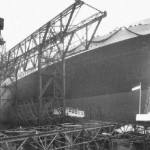
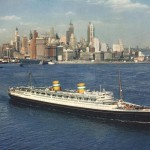
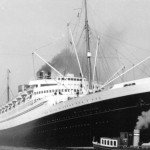
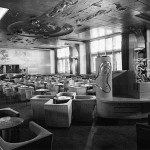
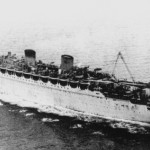
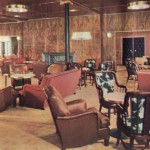
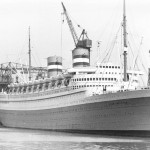
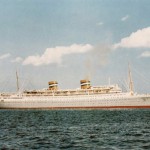
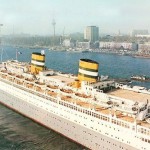
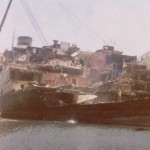
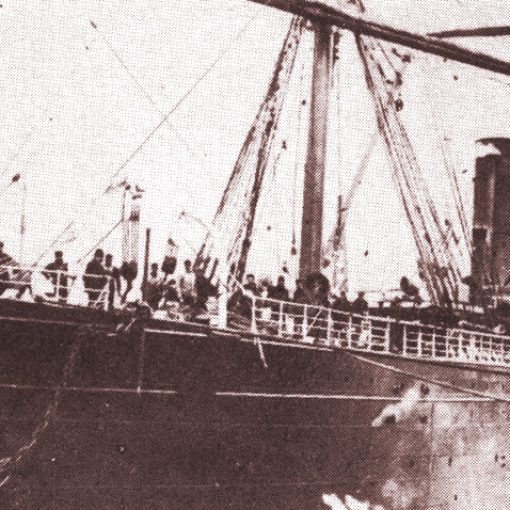

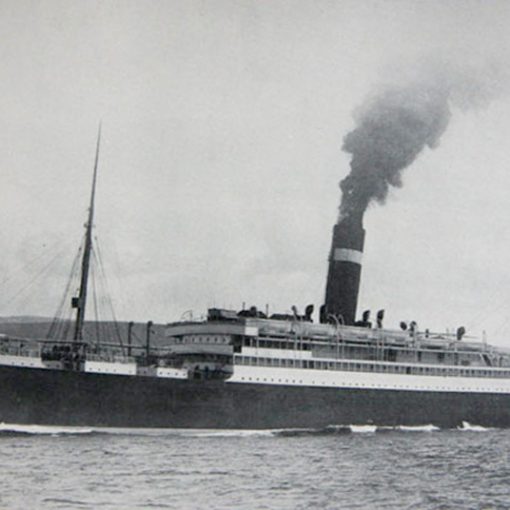
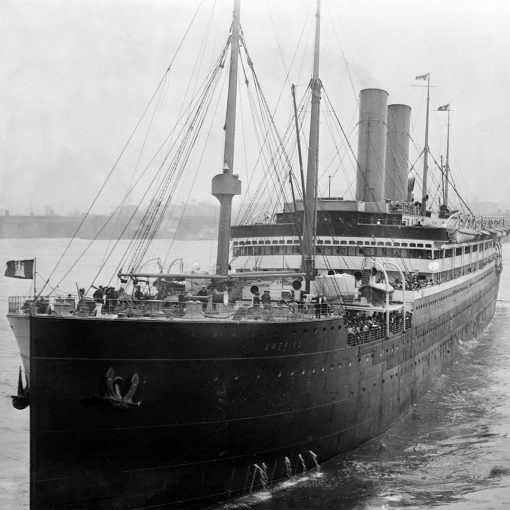
2 thoughts on “Nieuw Amsterdam (II)”
I believe my father was the Medical Officer on board the Nieuw Amsterdam from October 1945 until April 1946 when the ship was handed back to the Holland America Line by the British Ministry of Transport. If possible I would very much appreciate any information you could give me regarding the ship and her passengers and crew during this time. Can you suggest any websites which would give me information about this ship’s war time career which may help me with my research into my father’s war time experiences? I very much look forward to hearing from you.
For me, the first site to visit when looking for anything related to the Holland-America Line has always been the Unofficial HAL website, found at http://www.halpostcards.com/unofficial/.
More specifically, you will want to have all look at the section on passenger lists and related research, at http://www.halpostcards.com/unofficial/passlist.html.
Good luck in your continued search, and thanks for visiting TGOL!